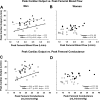Age and sex influence the balance between maximal cardiac output and peripheral vascular reserve
- PMID: 19959767
- PMCID: PMC2838638
- DOI: 10.1152/japplphysiol.00985.2009
Age and sex influence the balance between maximal cardiac output and peripheral vascular reserve
Abstract
We evaluated the influence of age and sex on the relationship between central and peripheral vasodilatory capacity. Healthy men (19 younger, 12 older) and women (17 younger, 17 older) performed treadmill and knee extensor exercise to fatigue on separate days while maximal cardiac output (Q, acetylene uptake) and peak femoral blood flow (FBF, Doppler ultrasound) were measured, respectively. Maximal Q was reduced with age similarly in men (Y: 23.6 +/- 2.7 vs. O: 17.4 +/- 3.5 l/min; P < 0.05) and women (Y: 17.7 +/- 1.9 vs. O: 12.3 +/- 1.6 l/min; P < 0.05). Peak FBF was similar between younger (Y) and older (O) men (Y: 2.1 +/- 0.5 vs. O: 2.2 +/- 0.7 l/min) but was lower in older women compared with younger women (Y: 1.9 +/- 0.4 vs. O: 1.4 +/- 0.4 l/min; P < 0.05). Maximal Q was positively correlated with peak FBF in men (Y: r = 0.55, O: r = 0.74; P < 0.05) but not in women (Y: r = 0.34, O: r = 0.10). Normalization of cardiac output to appendicular muscle mass and peak FBF to quadriceps mass reduced the correlation between these variables in younger men (r = 0.30), but the significant association remained in older men (r = 0.68; P < 0.05), with no change in women. These data suggest that 1) aerobic capacity is associated with peripheral vascular reserve in men but not women, and 2) aging is accompanied by a more pronounced sex difference in this relationship.
Figures



Comment in
-
Heterogeneity in human cardiovascular function contributes to a deeper understanding of integrative mechanisms.J Appl Physiol (1985). 2010 Mar;108(3):473-4. doi: 10.1152/japplphysiol.01385.2009. Epub 2009 Dec 17. J Appl Physiol (1985). 2010. PMID: 20019158 No abstract available.
References
-
- Bell C, Monahan KD, Donato AJ, Hunt BE, Seals DR, Beck KC. Use of acetylene breathing to determine cardiac output in young and older adults. Med Sci Sports Exerc 35: 58–64, 2003 - PubMed
-
- Clausen JP. Effect of physical training on cardiovascular adjustments to exercise in man. Physiol Rev 57: 779–815, 1977 - PubMed
-
- Fleg JL, O'Connor F, Gerstenblith G, Becker LC, Clulow J, Schulman SP, Lakatta EG. Impact of age on the cardiovascular response to dynamic upright exercise in healthy men and women. J Appl Physiol 78: 890–900, 1995 - PubMed
-
- Fu Q, Iwase S, Niimi Y, Kamiya A, Michikami D, Mano T. Effects of aging on leg vein filling and venous compliance during low levels of lower body negative pressure in humans. Environ Med 43: 142–145, 1999 - PubMed
Publication types
MeSH terms
Grants and funding
LinkOut - more resources
Full Text Sources
Medical

